<< Previous | Displaying results 6101-6125 of 6769 for "" | Next >>
Group portrait at the Children's Aid Society (Oeuvre de Secours aux Enfants, OSE) home for Orthodox Jewish children in Ambloy, France. Among those pictured: Kalman Kalikstein (front left), Binem Wrzonski (middle right), and Elie Wiesel (back center). Photo dated 1945–1946.
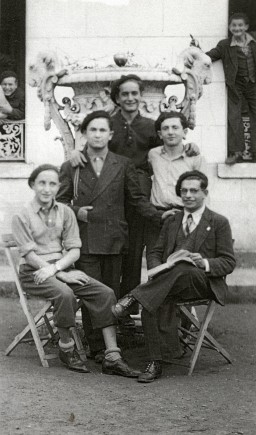
Michael Fink and his parents Manfred and Herta in the Westerbork camp, 1941–1944. Westerbork's primary role was as a transit camp. However, there was also a long-term camp population there. The Finks were among these residents. The family was in Westerbork until the spring of 1944, when they were deported to Theresienstadt. Michael and Herta survived, but Manfred was killed after being deported to Auschwitz-Birkenau and other concentration camps.
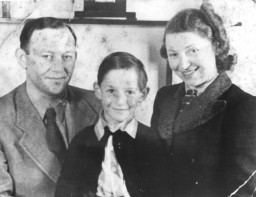
Signed portrait of German physician and sex researcher Magnus Hirschfeld (1868–1935). Hirschfeld sought to educate the public about sexuality. He advocated for the decriminalization of sexual relations between men, which was banned under Paragraph 175 of the German criminal code. Photo dated November 12, 1927.
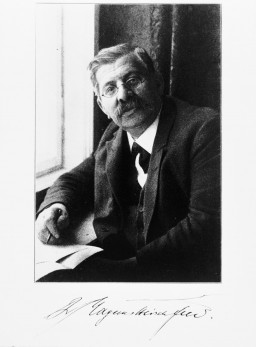
The American Eugenics Society displays an exhibit on health and eugenics at the Kansas Free Fair in 1929.
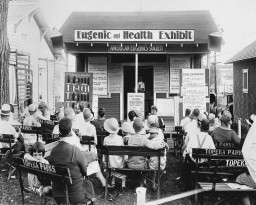
A segregated drinking fountain on the county courthouse lawn in Halifax, North Carolina. Photographed by John Vachon in April 1938.
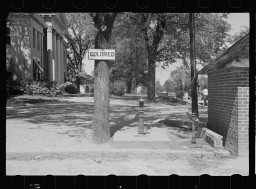
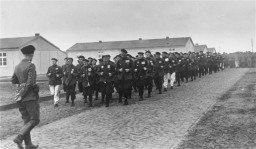
View of the wall enclosing the Esterwegen concentration camp, 1936.
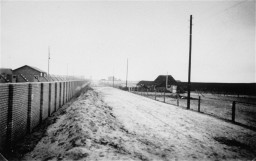
The defendants and their lawyers at the International Military Tribunal trial of war criminals at Nuremberg. Defendant Albert Speer (standing at right) delivers a statement in the dock. Nuremberg, Germany, November 20, 1945-October 1, 1946.
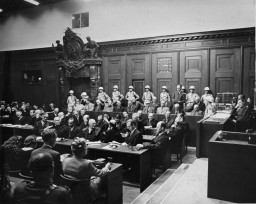
Julien Bryan was an important US documentary filmmaker and photographer who captured the everyday life, work, and culture of individuals and communities in many countries around the globe. Bryan was filming in western Europe in the summer of 1939. In the first week of September 1939, Bryan made his way to Warsaw just as all foreign reporters, diplomats, and Polish government officials were fleeing the capital in the wake of the German invasion. One of the few foreign photographers left in the city, he…
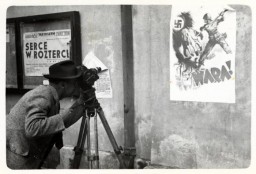
Adolf Hitler salutes a passing SS formation at the third Nazi Party Congress in 1927. Nuremberg, Germany, August 1927. The SS (Schutzstaffel, or Protection Squads) was originally established as Adolf Hitler’s personal bodyguard unit. It would later become both the elite guard of the Nazi Reich and Hitler’s executive force prepared to carry out all security-related duties, without regard for legal restraint.
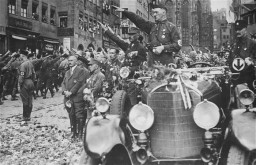
A prewar photograph of Basia and Moshe Golden (Gordon) taken ca. 1922–1925 in Swieciany, Poland (now Lithuania). Basia, along with two of their four children, Boruch and Teyva, were shot at the Ponary killing site by SS men and their Lithuanian collaborators in September 1943. Moshe died in the Klooga concentration camp. Two of their children survived, Niusia and Rwya. This photograph was saved by Niusia (now Anna Nodel) while she was in hiding.
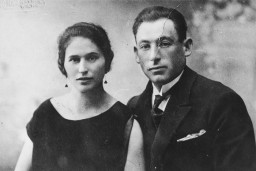
Prewar portrait of Pinchas and Roza Zygielbojm taken in 1936 in Warsaw, Poland. In 1942, they were taken into the Ponary forest outside of Vilna and killed by the SS and Lithuanian collaborators. Born in 1906, Pinchas Zygielbojm was an actor and brother of Szmul Artur Zygielbojm, a leader of the Jewish socialist Bund in interwar Poland and later a member of the National Council of the Polish Government-in-Exile in London.
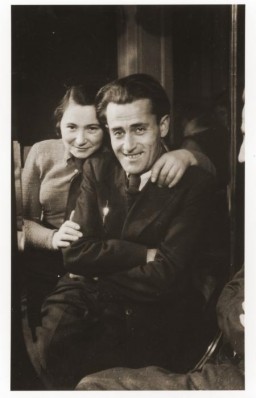
Shlomo Trabska was one of the many Jewish victims who were shot by the SS and Lithuanian collaborators at the Ponary killing site outside of Vilna. This photograph was taken in the late 1930s, when Shlomo was serving in the Polish army.
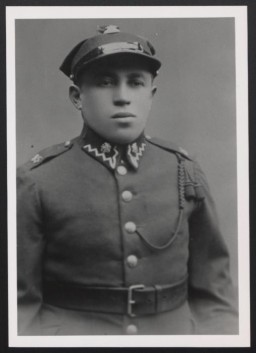
Execution site in the Ponary forest outside the Vilna ghetto. Lithuania, 1941.
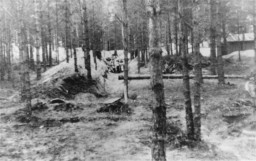
SS guards and Lithuanian collaborators force Jewish men into the Ponary forest, a site for mass killings outside of Vilna. German-occupied Lithuania, 1941.
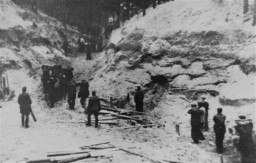
Jewish men are led to a site in the Ponary forest outside of Vilna, where they will be shot by Lithuanian collaborators, commanded by members of a German Einsatzgruppe. 1941.
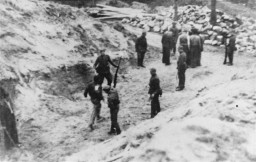
Two Jewish men, wearing badges identifying them as Jews, stand before SS men in the Ponary forest outside Vilna. Ponary served as the main Nazi killing site for Vilna's Jewish inhabitants. ca. July 1941.
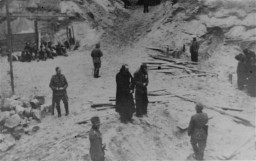
The Institute for Sexual Science was founded in Germany by Dr. Magnus Hirschfeld, a leading researcher of sex, sexuality, and gender. In 1933, the Nazis looted the institute and forced it to close. Photo published in 1924.
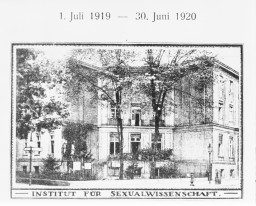
In February 1929, the Nazi newspaper "Der Stuermer" depicted a caricature of Magnus Hirschfeld. The Nazi Party attacked Dr. Hirschfeld for his ideas about sex, sexuality, and gender, as well as his Jewish ancestry.
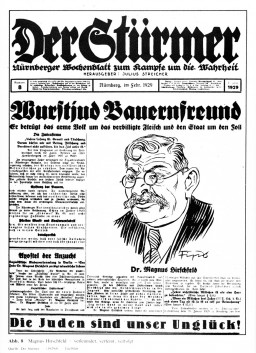
A newspaper clipping with the headline "Against the Un-German Spirit" announces the plundering of the Institute for Sexual Science. The photo shows students marching to the institute's entrance before the looting began on May 6, 1933. The institute's books and documents were among those targeted during the Nazi book burnings.
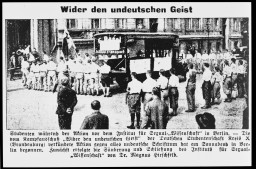
Students sit at their desks in a classroom at a Polish-language public elementary school in Lwów around 1930. In interwar Poland, Jewish children could attend public or private schools. The curriculum in these schools was based on a secular education, in contrast to the traditional heder where boys were schooled in Jewish texts and traditions. This particular school was located in the city’s predominantly Jewish neighborhood and almost all of the students were Jewish. Before attending this school,…

This group portrait shows instructors of the Hanoar Hatzioni Zionist youth movement at a summer camp in Lwów in 1936. The uniforms the young men wear, combined with the summer camp setting, bear similarities to the wider European scouting movement. Between World War I and World War II, scouting was very popular in Poland among young people. Scouting had a strongly national character. It inspired youth movements for Jews, who were excluded from scouting or who wanted to express their own national…
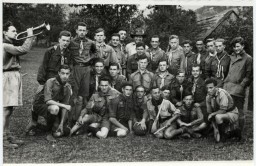
Siegfried Graetschus (right) and an unidentified man stand in front of Grafeneck, the first killing center established under Aktion T4 (the Nazi Euthanasia Program). Before joining the T4 program, Graetschus worked at the Sachsenhausen concentration camp. Photo dated early 1940.
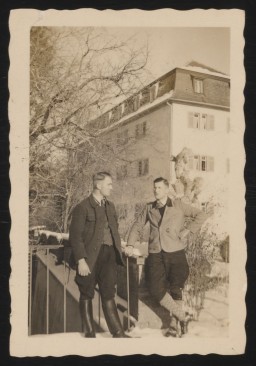
Johann Niemann (left) and an unidentified man walk on the snow covered driveway to Grafeneck Castle in early 1940. Niemann worked as a stoker at Grafeneck, cremating victims' corpses in the crematoria. He later became the deputy commander of the Sobibor killing center.
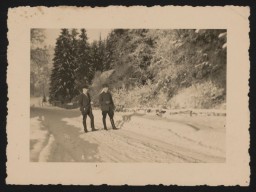
A family stands outside of their wagon while interned in a Zigeunerlager ("Gypsy camp"). In the background, children are crowded around Eva Justin. Justin worked for the Center for Research on Racial Hygiene and Demographic Biology. Schleswig-Holstein, Germany, 1938. During the Nazi era, Dr. Robert Ritter was a leading authority on the racial classification of people pejoratively labeled “Zigeuner” (“Gypsies”). Ritter’s research was in a field called eugenics, or what the Nazis called…
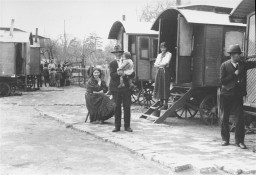
We would like to thank Crown Family Philanthropies, Abe and Ida Cooper Foundation, the Claims Conference, EVZ, and BMF for supporting the ongoing work to create content and resources for the Holocaust Encyclopedia. View the list of donor acknowledgement.